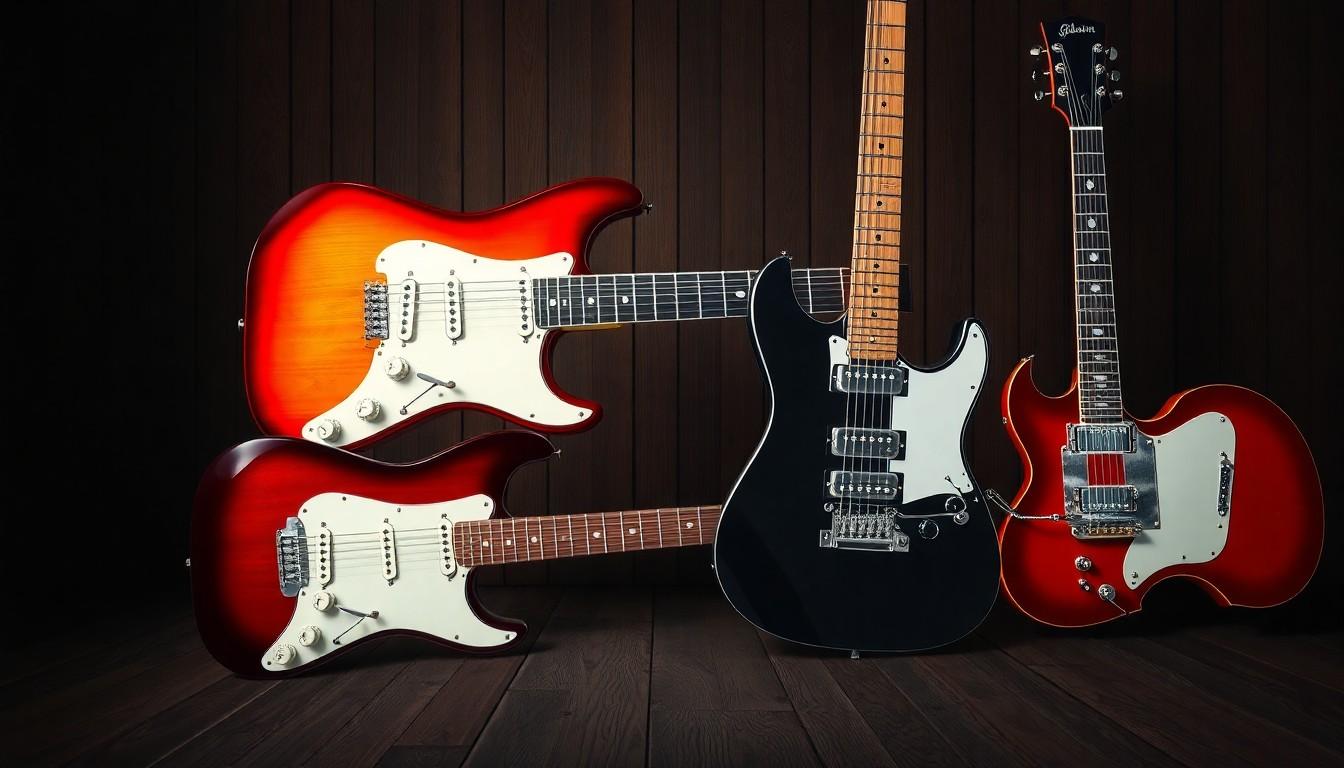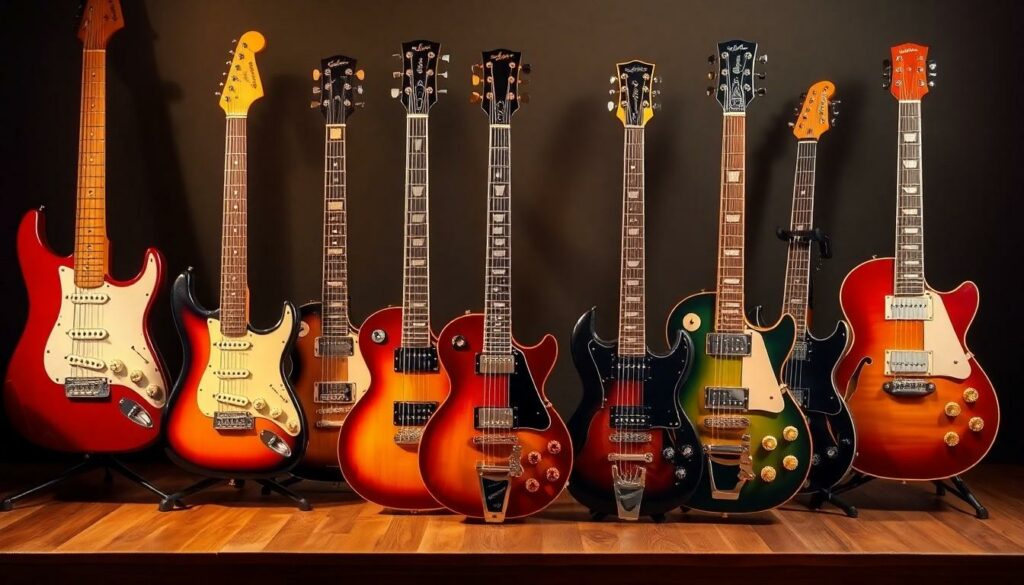Electric guitars come in all shapes and sizes, each curve and contour telling its own story. From the classic Stratocaster to the sleek Telecaster, the design isn’t just about looks—it influences the sound and playability. Imagine picking up a guitar that feels like it was crafted just for your style, enhancing every riff and solo.
But it’s not just the iconic silhouettes that matter. Modern innovations have introduced a variety of shapes that push the boundaries of tradition, offering musicians endless possibilities to express themselves. Whether you’re a seasoned pro or just starting out, understanding electric guitar shapes can elevate your performance and inspire creativity. Dive into the fascinating world of electric guitar shapes and discover which design resonates with your musical journey.
Electric Guitar Shapes
Electric guitar shapes significantly influence sound and playability, catering to diverse musical styles. The Stratocaster, recognized for its double cutaway body, offers enhanced access to higher frets and a balanced tonal range. Telecasters feature a single cutaway design, providing bright, cutting tones ideal for country and rock genres. Les Paul models present a solid single cutaway body with humbucker pickups, delivering warm, rich sounds suitable for blues and hard rock.
Offset bodies, like those of the Jazzmaster and Jaguar, provide comfortable playing positions and distinct tonal characteristics favored in alternative and surf music. Superstrats incorporate advanced features such as locked tremolos and high-output pickups, targeting genres that require technical virtuosity and versatility. Hollow-body guitars, including the Gibson ES-335, offer resonant, acoustically rich tones perfect for jazz and blues performances.
Popular Electric Guitar Shapes
| Shape | Key Features | Typical Genres |
|---|---|---|
| Stratocaster | Double cutaway, three single-coils | Rock, blues, pop |
| Telecaster | Single cutaway, two single-coils | Country, rock |
| Les Paul | Single cutaway, dual humbuckers | Rock, metal, blues |
| Jazzmaster | Offset body, floating tremolo | Indie, surf, alternative |
| Superstrat | Extended range, high-output pickups | Metal, hard rock |
| Hollow-body | Semi-hollow, single or dual pickups | Jazz, blues, rockabilly |
Understanding these shapes enables musicians to select instruments that align with their playing style and sonic preferences.
Popular Electric Guitar Shapes

Electric guitars come in various shapes, each offering unique sound and playability features. Understanding these shapes helps musicians choose the right instrument for their style.
Stratocaster
The Stratocaster stands out with its double cutaway body, providing easy access to higher frets. Designed by Fender, it delivers a balanced tonal range suitable for diverse genres. The contoured body enhances comfort during play, while its three single-coil pickups offer bright, clear sounds. Iconic players like Jimi Hendrix and Eric Clapton have favored the Stratocaster for its versatility. Its sleek shape not only looks appealing on stage but also contributes to superior resonance. Musicians appreciate its lightweight construction and ergonomic design, making it ideal for both live performances and studio recordings. Additionally, the Stratocaster’s tremolo bridge allows expressive pitch variations, expanding its sonic capabilities.
Telecaster
The Telecaster features a single cutaway design, delivering bright and cutting tones perfect for country and rock music. Known for its simplicity and durability, this Fender model boasts a robust single-coil pickup configuration. Its solid body provides excellent sustain and minimal feedback, making it reliable for high-gain settings. The Telecaster’s straightforward shape is easy to handle, facilitating comfortable playing over extended periods. Musicians like Bruce Springsteen and Keith Richards appreciate its distinctive twang and versatility. The bridge design enhances intonation stability, while the neck offers smooth, fast playability. Its classic aesthetic and timeless design ensure the Telecaster remains a staple in both live performances and recording sessions.
Les Paul
The Les Paul is recognized for its single cutaway solid body design that produces warm, rich tones ideal for blues and hard rock. Manufactured by Gibson, it features dual humbucker pickups delivering powerful, noise-free sound. The carved maple top provides enhanced sustain and resonance, while the mahogany body contributes to its characteristic warmth. The Les Paul’s contoured shape ensures comfort during prolonged use, and its set neck design offers smooth playability. Legendary guitarists like Jimmy Page and Slash have relied on the Les Paul for its robust build and expressive sound. Its versatile tonal range accommodates various styles, from smooth jazz to heavy metal, making it a favorite among professional musicians.
SG
The SG model showcases a double cutaway body, allowing greater access to higher frets and facilitating faster play. Gibson’s SG is lightweight yet sturdy, offering exceptional playability and comfort. Its sharp, angular design contributes to a distinct aesthetic and improved balance. Equipped with dual humbucker pickups, the SG delivers a powerful and aggressive sound suitable for rock and metal genres. The slim neck profile enables swift finger movements, enhancing technical performance. Artists like Angus Young and Tony Iommi favor the SG for its responsiveness and dynamic range. Additionally, the SG’s versatile electronics provide a wide array of tonal options, making it adaptable for both live and studio environments.
Factors to Consider When Choosing a Shape
Selecting the right electric guitar shape enhances both performance and personal satisfaction. Various factors influence this decision, ensuring the instrument aligns with the musician’s needs.
Playability
Guitar shape impacts comfort and ease of play. Ergonomic designs reduce hand fatigue during extended sessions. For instance, double cutaway bodies like the Stratocaster offer better access to higher frets, facilitating soloing and complex riffs. Neck profiles also play a role; slimmer necks allow faster movement, ideal for genres like metal and jazz. Weight distribution affects balance, with heavier models like the Les Paul providing a solid feel, while lighter shapes like the SG enable swift changes. Additionally, body contours and finishes can influence how naturally the guitar fits against the body, enhancing overall playability.
Aesthetics
Visual appeal reflects a musician’s personal style and stage presence. Iconic shapes such as the Telecaster’s single cutaway or the Jazzmaster’s offset body offer timeless looks recognized across genres. Custom finishes and unique contours allow for individual expression, making each guitar distinct. Color choices range from classic sunburst to vibrant, modern hues, catering to varied tastes. Moreover, inlays and hardware details add to the visual complexity, contributing to the guitar’s overall attractiveness. Aesthetic considerations not only influence how the guitar looks but also how confident a player feels while performing.
Sound and Performance Comparison
Different electric guitar shapes influence both sound quality and performance characteristics. Stratocasters provide a balanced tonal range, suitable for versatile music styles. Telecasters deliver bright, cutting tones ideal for country and rock genres. Les Pauls offer warm, rich sounds favored in blues and hard rock settings. SG models produce aggressive tones with enhanced sustain, popular in metal and rock music.
A table below summarizes the sound attributes and performance features of key electric guitar shapes:
| Guitar Shape | Tonal Characteristics | Performance Features |
|---|---|---|
| Stratocaster | Balanced, bright, versatile | Double cutaway for easy access to higher frets, ergonomic body for comfortable play |
| Telecaster | Bright, cutting, clear | Single cutaway design, lightweight body |
| Les Paul | Warm, rich, sustaining | Set neck construction, heavier body for enhanced sustain |
| SG | Aggressive, punchy, fast | Lightweight double cutaway, thin body for quicker playability |
| Jazzmaster | Smooth, mellow, complex | Offset body for better balance, rich vibrato system |
| Superstrat | Versatile, high-output | Modern features like locking tremolo, sleek body design for extended range |
Stratocasters excel in versatility, making them suitable for various genres such as blues, rock, and pop. Their double cutaway design allows players to reach higher frets effortlessly, enhancing performance flexibility. Telecasters, with their single cutaway, emphasize brightness and clarity, making them a staple in country and rock music for their distinctive twang.
Les Pauls stand out with their warm and sustaining tones, attributed to their solid body and set neck construction. These features contribute to a fuller sound, preferred in genres requiring depth and resonance. Conversely, SG guitars offer a lighter body and faster neck, facilitating quick playing and aggressive sound, which appeals to metal and hard rock musicians.
Jazzmasters provide smooth and complex tones, supported by their offset body design that ensures better balance during performance. This shape is favored in alternative and surf music for its unique sound and comfortable playing position. Superstrats combine modern features with sleek designs, offering high-output sounds and extended range capabilities, making them ideal for progressive and technical playing styles.
Understanding these sound and performance differences allows musicians to select a guitar shape that aligns with their musical style and technical needs, enhancing both their sound expression and playing experience.
Choosing the Right Shape for You
Selecting the ideal electric guitar shape enhances both performance and comfort. Musicians prioritize ergonomics to minimize hand fatigue during extended play sessions. Double cutaway bodies, like the Stratocaster and SG, provide easier access to higher frets, facilitating complex solos and fast playing. Single cutaway designs, such as the Telecaster, offer a classic look with bright tones suitable for genres like country and rock.
Aesthetic preferences influence many choices. Artists often select shapes that reflect their personal style and stage presence. Les Paul models feature a sleek, solid body that complements blues and hard rock, while offset bodies like the Jazzmaster cater to alternative and surf musicians seeking a unique appearance.
Sound quality plays a crucial role in decision-making. Hollow-body guitars deliver rich, resonant tones ideal for jazz and blues, whereas superstrats offer high-output capabilities suitable for heavy metal and versatile genres. Weight distribution impacts overall balance; lighter models like the SG ensure comfort during vigorous performances, whereas heavier guitars like the Les Paul provide sustain and depth.
Budget considerations affect shape selection as well. Standard shapes generally offer better value, while custom or limited-edition shapes may require a higher investment. Evaluating specific needs and preferences ensures that musicians choose a guitar shape that aligns with their playing style, sonic preferences, and personal identity.
| Guitar Shape | Key Features | Ideal For |
|---|---|---|
| Stratocaster | Double cutaway, balanced tones | Rock, blues, versatile genres |
| Telecaster | Single cutaway, bright tones | Country, rock |
| Les Paul | Solid body, warm sounds | Blues, hard rock |
| SG | Lightweight, aggressive tones | Rock, metal |
| Jazzmaster | Offset body, smooth tones | Alternative, surf |
| Superstrat | High-output, versatile | Metal, various genres |
| Hollow-Body | Rich, resonant tones | Jazz, blues |
Choosing the right guitar shape involves balancing these factors to match individual playing styles and musical goals.
Maintenance and Care
Proper maintenance ensures electric guitars retain their shape and sound quality over time. Regular cleaning prevents the buildup of dust and oils, which can affect playability and appearance. Use a soft, dry cloth to wipe down the body, neck, and strings after each use. For deeper cleaning, apply a guitar-specific cleaner following the manufacturer’s instructions.
Humidity control is crucial for preserving the guitar’s structural integrity. Store the instrument in a climate-controlled environment, ideally between 45-55% relative humidity. Investing in a quality guitar case with built-in humidity control can protect against fluctuations that may cause wood warping or cracking.
String care enhances both tone and longevity. Change strings every 1-3 months, depending on usage frequency. When replacing strings, clean the fretboard with a suitable conditioner to remove residue and prevent drying. Lubricate the nut and bridge periodically to ensure smooth tuning and optimal string performance.
Regular inspections identify potential issues early. Check for loose hardware, such as tuning pegs and bridge components, tightening them as needed. Inspect the fretboard for wear and address any uneven frets by consulting a professional luthier. Ensuring all components are secure maintains the guitar’s playability and extends its lifespan.
Proper storage complements maintenance routines. When not in use, keep the guitar in its case to protect it from physical damage and environmental factors. Avoid leaving the instrument in extreme temperatures or direct sunlight, which can distort the shape and damage finishes.
Professional setups enhance performance and comfort. Schedule annual visits to a technician for comprehensive assessments, including neck alignment, intonation adjustments, and electronics checks. These setups ensure the guitar remains in optimal condition, providing the best playing experience.
By following these maintenance and care practices, electric guitars maintain their shape, functionality, and aesthetic appeal. Consistent attention preserves both the instrument’s value and the musician’s investment, allowing for continued enjoyment and performance.
Selecting the right electric guitar shape is essential for any musician. It’s about matching an instrument to your style and enhancing your creative flow. With so many designs each offering unique advantages the perfect shape can elevate your performance. Comfort and tone go hand in hand when you choose a guitar that feels right and sounds great. Whether you prefer classic models or modern innovations finding the right shape can inspire your musical journey and open up new possibilities. Embrace the diversity of electric guitar shapes and let your choice reflect your personal expression and artistic goals.



